Table I ITTS and INTS systems and final waste forms
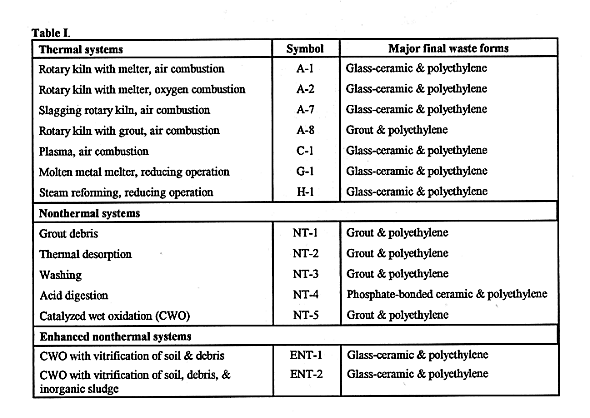
C. R. Cooley
USDOE
EM-50
W. J. Quapp, G. L Anderson, W. E. Schwinkendorf and T. E.
Bechtold
LMITCO
C. Biagi
Morrison Knudsen
G. D. Knight
Waste Policy Institute
ABSTRACT
The U.S. Department of Energy Office of Science and Technology has been sponsoring a series of studies of integrated mixed waste processing systems to identify technology development needs. The studies have included 20 systems based on using high temperature processes (Thermal) for organic destruction. In addition, five systems have been evaluated that used low temperature processes (Nonthermal). Two hybrid systems have also been evaluated which combine the low temperature organic destruction with vitrification of residues. This paper summarizes the results from these studies.
INTRODUCTION
From 1993 to the present, the Department of Energy, Office of Science and Technology (OST), has sponsored a series of systems engineering analyses to guide its future research and development (R&D) programs for the treatment of mixed low-level waste (MLLWa). The technologies were evaluated as part of a total treatment system capable of processing the U.S. Department of Energy (DOE) MLLW to meet the Environmental Protection Agency's (EPA) Land Disposal Restrictions (LDR). The first study, Integrated Thermal Treatment Systems (ITTS)--Phase 1, looked at relatively mature thermal treatment technologies (1). After its completion, it was extended to Phase 2 to consider more innovative and developmental thermal treatment technologies (2). As a result of a technical review (3) of Phases 1 and 2 of the ITTS study, a similar study of nonthermal treatment systems, known as the Integrated Nonthermal Treatment Systems (INTS) study (4), was subsequently conducted. Subsequent to the INTS, the final study in this series looked at five Enhanced Nonthermal Systems (ENTS) study that includes integrating nonthermal and thermal technologies (5). The treatment systems were conceptually designed to treat MLLW in compliance with Resource Conservation and Recovery Act (RCRA) and to generate final waste forms, which would be expected to meet DOE performance assessment requirements at a disposal site.
In all, thirty systems were conceptualized to process the same mixture of MLLW at 2927 lbs/hr in a single facility operating 4032 hr/yr for 20 years. This processing capacity would treat approximately 236 million pounds over the 20-year assumed operating period. Using an assumed density of 64 lb/ft3, this is equivalent to 3.7 million cubic feet. The DOE inventory of MLLW from all DOE sites was used as the starting point for the 1993 study (6). This inventory consisted of a wide range of combustible and noncombustible materials such as paper, plastics, metals, concrete, soils, sludges, etc., contaminated with trace quantities of radioactive materials and RCRA regulated waste. From this inventory, an average waste profile was developed for use in the ITTS Study (7).
Although estimates of DOE MLLW inventory volume and content have varied over the period of the studies (1993 to 1996) as improved knowledge has been obtained by the sites, the changes in the waste profile are believed to have only a small impact on the results of these studies. Consequently, the same composition was used for all studies to allow comparison of the results. The system design capacity used in these studies would treat approximately 72% of the currently estimated MLLW inventory plus 5 years of projected generation (8).
The ITTS study was guided by a technical support group (TSG) consisting of representatives from several DOE laboratories as well as consulting engineers involved in the private sector hazardous waste treatment industry. The TSG also included one nontechnical person who had been involved in a variety of DOE oversight activities for the State of Colorado. This individual provided the ITTS Study members "public insight" for the evaluation of the technologies.
Because of the growing importance of stakeholder involvement in DOE decision making, as well as recommendations from the peer review (3), public involvement in the subsequent INTS study was expanded to a working group of 20 tribal and stakeholder representatives (Native Americans, state and local governments, citizens, environmental groups, and personnel from private companies). The Tribal and Stakeholder Working Group (TSWG) was organized to provide perspectives on the formulation of the INTS studies and to provide comments on the process and results of the INTS and ITTS studies. The TSWG developed a group of principles to reflect their concerns, namely: minimize effluents; minimize effect on human health and the environment; minimize waste generation; address social, cultural, and spiritual considerations (e.g., land use); and provide accurate and understandable information.
These principles were compared to the technical criteria used in the previous studies and found to be generally consistent. Accordingly, the principles were used to guide the evaluation of the treatment systems. In addition to these principles, other measures for comparison included total life cycle costs (TLCC), performance, worker safety, and public health.
This paper summarizes the results of detailed reports on the studies (1,2,4,5,9) and presents comparisons of system performance indicators such as energy requirements, reagent requirements, land use, final waste volume, and aqueous and gaseous effluents. Comparisons of costs and cost sensitivities to the study assumptions are presented in a companion paper in this conference (10). Safety and health issues (comparative risks) are still being evaluated and will be reported later.
TECHNICAL APPROACH AND BASIS
These studies were formulated and performed by a diverse group of individuals (in addition to the authors) representing several DOE laboratories and industry consultants with expertise in waste treatment and air pollution control. Conceptual facilities were developed to comply with DOE requirements as well as EPA requirements for RCRA treatment. The conceptual air pollution control (APC) systems were developed to exceed the requirements of RCRA by lowering emissions by at least a factor of ten. The systems were designed to accommodate the treatment of waste contaminated with plutonium, and thus, requirements for triple containment barriers were included in parts of the facility. Remote handling was used for high risk areas such as waste sorting. Systems were developed using combinations of technologies commonly used in hazardous waste treatment and innovative technologies being developed by DOE laboratories and by the private sector. The technologies ranged from very mature processes, such as incineration, to developmental processes, such as acid digestion. In all, 20 thermal systems, 5 nonthermal, and 5 enhanced nonthermal systems were evaluated. A survey of nonthermal technologies was made to obtain information on all potentially applicable processes without regard to the level of maturity (11).
After development of the basic treatment system concepts, detailed functional allocation diagrams and system flowsheets were prepared. Equipment layouts and facility isometric drawings were made to enable the facility size to be estimated. Detailed equipment lists were prepared for cost estimating. For the studies, conceptual system designsb were developed and life cycle costs (in present year dollars) were estimated assuming a government-owned, contractor-operated facility. Life cycle costs were estimated for all major cost components such as technology development and demonstration, preconstruction project operations, construction, operation and maintenance, decommissioning, and waste disposal. The waste was assumed to be received onsite and disposed onsite. Thus, no costs associated with transportation to or from the treatment facility were included. Subsequent studies have shown that transportation cost would be very small (<1%) compared to the TLCC. Mass and energy balances were developed using the ASPEN PLUS© computer code to determine the energy requirements, quantity of process reagents, quantities of gaseous and liquid effluents, and the quantity of solidified final waste forms going to disposal. Lastly, after the design effort was completed, assessments of research and development needs were conducted.
RESULTS
This paper presents a limited comparison of the studies' results--seven thermal systems representative of the ITTS study, the five nonthermal systems evaluated in the INTS study, and two ENTS systems. The thermal systems were selected to represent both a combination of some of the most mature thermal systems and some of the innovative thermal technologies under development or demonstration for DOE. The INTS and ENTSs were selected as representative of the systems in those studies. The systems are identified in Table I. System A-8 represents the current state-of-the-art technology of incineration and grout stabilization of the ash. Detailed system descriptions, flowsheets, and related information are available in References 1, 2, 4, and 5.
Table I ITTS and INTS systems and final waste forms

A detailed review of the DOE waste inventory found that only about 20% of the MLLW to be combustible (6). However, the noncombustible material, assumed to be contaminated with RCRA-regulated materials, requires treatment to meet LDR requirements.
Thermal systems, which treat waste at high temperatures and produce vitreous or glass-ceramic (hereafter called glass-ceramic) final waste forms for disposal and metal ingots for disposal or recycling, can treat most of the combustible and noncombustible waste. High temperature processing is capable of destroyingc all organic material. Inorganic residuals will become part of the ash that is stabilized to a leach resistant final waste form by either being vitrified in a separate melter, as in three of the thermal systems (A-1, A-2, H-1), or vitrified in the primary thermal treatment system as in the other three thermal systems (A-7, C-1, G-1). The residuals for the other thermal system evaluated (A-8) were stabilized in grout.
The nonthermal processes for organic destruction, limited to a maximum temperature of 350°C, can process only a small portion of the total waste inventory. Consequently, other unit operations were employed to treat the inorganic materials. An example is low temperature vacuum thermal desorption which removes organic contaminants for treatment by the organic destruction unit. Other processes included grouting of debris and soil washing. The INTS stabilized the residuals in grout and polymer. The ENTS employed vitrification for residual stabilization. For the waste that could not be processed by the thermal or nonthermal main treatment technology, additional subsystems (e.g., mercury amalgamation, metal decontamination, special waste, etc.) were provided so that all of the waste identified in the inventory could be processed.
For thermal systems (ITTS) about 70% of the total waste could be processed through the main thermal treatment unit, whereas for nonthermal (INTS) and enhanced (ENB) systems, only 10% to 20% of the waste could be processed through the nonthermal and enhanced nonthermal organic destruction unit. Because of chemical and physical matrix complexity, the nonthermal systems required more unit operations to handle the entire waste stream.
Energy Usage. High energy use is associated with systems that operate at high temperatures or use significant amounts of electricity. These studies have shown that when viewed on a percentage of life cycle cost the energy costs for even the most energy intensive processes are less than 1% of TLCC. The comparison of hourly energy cost is provided in TableII.
Table II Comparison of Energy, Reagent Usage (Excluding Waste
Stabilization Reagents), Total Incoming Transportation Requirements (Including
Waste, Reagents, Stabilization Materials), and Total Outgoing Loaded
Transportation Requirements (Including Waste to Disposal and Recycled Metals to
Storage)
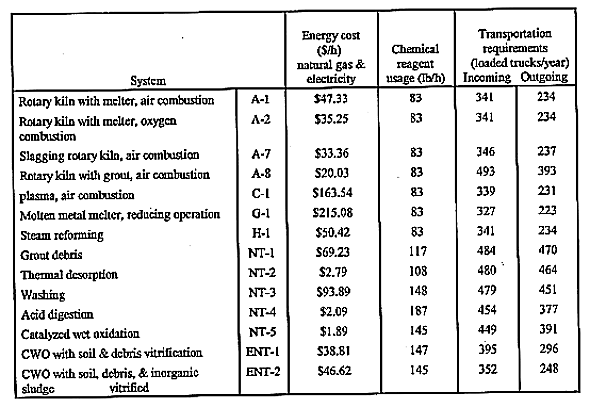
Reagent Usage. Neither the thermal nor nonthermal systems use large quantities of chemical reagents. Thermal systems use less -- only sodium hydroxide for the off gas scrubber and copper for amalgamation of mercury. The hourly consumption of reagents is shown in Table II. Stabilization agents (glass-former, cement, or polymer) are not included in the reagent totals of Table II.
Transportation of Materials The incoming waste, if shipped in trucks, would require about 270 truck loads (loaded to 44,000 lb/truck) per year. Thermal treatment systems, except for System A-8 which used grout as a final waste form, required the least amount of incoming process materials (about 70 truck loads per year). A large percentage of this was soil or reagents used for glass forming. The thermal system with the grout waste form (A-8) option required 210 truck loads per year for incoming grout materials. Nonthermal treatment systems required nearly 200 truck loads per year of incoming reagent materials and stabilizing agents. The incoming transportation requirements are shown in Table II.
The studies assumed that waste would be disposed on the site where it was treated. However, if that were not the case and waste was transported offsite to a disposal facility, then there would be additional transportation requirements. Table II shows the quantity of trucks needed for waste transport to the disposal facility. On a daily basis, we have less than 1.5 trucks per day for any system. Consequently, the same trucks (assuming they meet the transport regulation requirements) that bring materials to the site could transport the processed final waste forms to the disposal site.
Liquid, Gaseous and Solid Effluents. Mass balance calculations performed using the ASPEN PLUS© computer code were used to estimate the production of process effluents -- gases, liquids, and solids. The mass balance included all incoming waste, process reagents, air, water, soil or other stabilization agent, etc. Output materials included combustion gases, liquids, and multiple forms of solids including recyclable ferrous metal, amalgamated mercury, and the final disposal waste forms such as glass-ceramic, grout, polymer or phosphate bonded ceramic.
Most water used in the systems is passed through an aqueous cleanup system and is internally recycled. The aqueous waste treatment system is designed to remove gross immiscible organics, precipitate and filter inorganic contaminants, destroy soluble organics using ultra violet (UV) photo oxidation, and remove any residual levels of organics and inorganics with activated carbon beds and ion exchange units, respectively. The resulting precipitates are stabilized in polymer.
Performance of the aqueous waste treatment system is expected to meet or exceed regulatory requirements for water discharge. Because water is a product of oxidation, there is a continuous net generation for most systems. Systems operating in a pyrolysis mode consume water. The results of this analysis is presented in Table III.
Table III Comparison of Effluents (All Units in (lb/h))
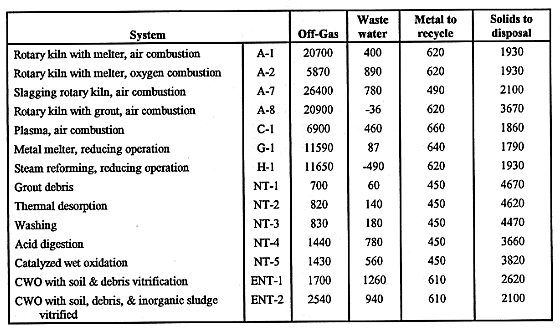
Off-gas production for the thermal systems varies depending on whether air or oxygen is used for combustion, or whether natural gas or electricity is used as the heat source. The lower off-gas production from the nonthermal systems results from the elimination of fuel and oxygen for the heat source, the lack of air in-leakage associated with the incineration systems, and less total organic oxidation.
Metal to recycle is greater for thermal than nonthermal systems. This difference is contingent on the assumed technical and economic feasibility of metal recycle. These differences are small in terms of the impact on disposal cost.
The amount and type of stabilized solids sent to disposal is a key discriminator among the technologies. The thermal and nonthermal systems that use grout (or phosphate bonded ceramic) and polymer have substantially higher disposal volumes. The treated and stabilized waste sent to disposal varied from 3000 to over 4000 lb/hr for nonthermal stabilization and from 1800 to over 2000 lb/hr for thermal stabilization processes using vitrification. Approximately equal amounts of secondary residue, i.e., internally-generated salts stabilized in polymer, were produced by both nonthermal and thermal systems. Secondary residue varied from 200 to 365 lb/hr for nonthermal systems and was approximately 250 lb/hr for thermal systems.
DISCUSSION OF RESULTS
One of the primary evaluation criteria for both the TSWG and technical team members is the generation of residuals from the treatment processes. Consequently, minimization of residues is important. Waste treatment system are designed to produce solid residues which retain the hazardous material and to release essentially nontoxic gases and liquids.
Volume Reduction. As shown in Table IV, for thermal systems, the waste treatment process reduced the incoming waste volume by about 70%, with the notable exception of the rotary kiln option in which grout was used for stabilization (A-8). In this case, the waste volume was reduced 32%. Waste volumes from nonthermal systems were reduced about 5 to 20%. These volume reduction estimates are very sensitive to the assumed density of the incoming waste that was assumed to be 64 lb/ft3 for this study (Densities ranging from 32 to 64 lb/ft3 have been previously reported). A lower assumed value for the incoming waste will result in higher volume reductions for all systems.d Volume reduction for System G-1 may be overstated if metal recycle is not possible or economic. If ferrous metal recycle is not viable, the volume reduction ratio for System G-1 will be similar to System A-1.
Table IV Comparison of Volume Reduction (Vol %)
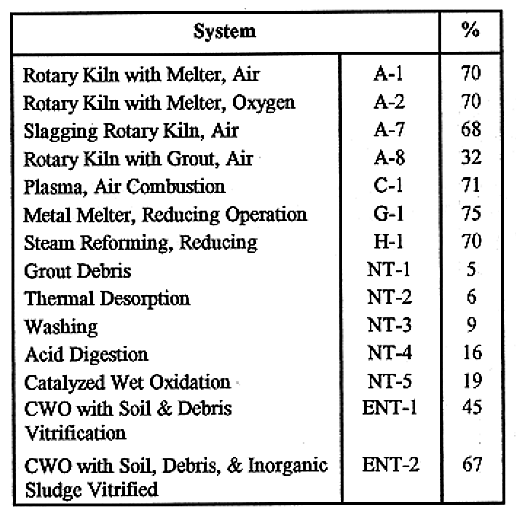
Air Pollution Control. For nonthermal systems, carbon dioxide is the largest component of off-gas; for thermal systems which use air for combustion, nitrogen is the largest constituent of gaseous emissions. For systems producing lower off-gas volumes and operating at lower temperatures, there is lower cost (2% of TLCC for nonthermal and 5% for thermal systems) associated with the air pollution control system and a decreased challenge from entrainment of particulate. The generation of semivolatile toxic metals is also greatly reduced.
The components of thermal and nonthermal APC systems are similar and perform similar functions. Both APC systems are designed to have total toxic emissions that are at least a factor of ten less than release limits required by the EPA when the studies began.
Although, it is not possible to precisely estimate the actual concentration of toxic contaminants in the off-gas for any system, using conservative decontamination factors for particulate for each of the steps in an APC system, a rough estimate of the total removal efficiencye is made as shown in Table V. The removal efficiency physically represents the percent of the initial material removed at each stage of the APC or by the entire system. As the cost of a high performance APC system as used in these studies represents only about 2 to 5% of the total life cycle costs of the entire system, it seems logical to use the best available APC system for any thermal or nonthermal treatment system. Comparing total particulate removal efficiencies shown in Table V, it is clear that both thermal and nonthermal APC systems will remove essentially all particulate. These systems should exceed present standards by a large margin. However, actual test results are needed to demonstrate such performance to regulators and the public.
Table V Estimated Removal Efficiency of APC Systems for Particulate
Removal
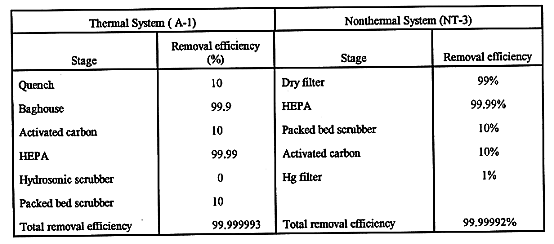
System Maturity and Performance. The thermal treatment systems evaluated incorporate both developmental and commercial technologies. All thermal systems that subject waste to very high temperatures should be able to meet EPA destruction requirements for organic waste residues. Systems producing the glass-ceramic waste form will meet EPA and DOE leaching performance standards based on extensive laboratory tests. Production of a glass waste form further assures organic destruction os maximized.
While incineration (thermal treatment) is the EPA's best demonstrated available technology for hazardous waste, no thermal treatment systems have been deployed on radioactive waste similar to the waste profile used in these studies.f The thermal systems based on rotary kiln technology are very mature and have minimum implementation and performance risks. The major unit operation with implementation and performance risks in two of the systems (A-1 and A-2) is the ash melter. Melter systems have been tested in pilot plant demonstrations, and some are being deployed for waste treatment by industry. System A-7, which employs a slagging rotary kiln and does not have a separate melter, has the least performance risk of any completely thermal system evaluated. Slagging rotary kilns have been deployed throughout the world for the treatment of hazardous waste. System H-1 has been deployed commercially on wood pulp waste but not on hazardous or radioactive waste. This system has a separate melter for treating the residues from steam reforming and inorganic materials in the waste stream. A melter employed to perform this function has higher risks than a melter employed to only vitrify the ash residuals from the rotary kiln as in Systems A-1 and A-2.
Other thermal treatment technologies such as the plasma melter and molten metal melter subsystems are at the pilot plant stage of development. These thermal systems have had very little operating time and typical developmental problems associated with refractories and plasma torch lifetime have been encountered. These, as yet unproven, systems should be available for deployment in a few years and should perform well on MLLW.
The nonthermal technologies evaluated have been tested only at bench or small pilot scale. Thus, confidence in their successful deployment must await further demonstration testing. Other than ultraviolet light oxidation which is used commercially for destruction of dilute organic contaminants in aqueous waste streams, none are used commercially. Final organic destruction effectiveness and the potential for generation of toxic organics in the off gas stream is unknown.
Nonthermal final waste forms -- grout and polymer -- should meet the EPA and DOE requirements if organic destruction is effective in the treatment stages. However, at least 5 to 10 years of additional R&D are required to bring the nonthermal technologies to an equivalent state of maturity as the least mature thermal technologies. Figure I shows a relative maturity index for all systems which is based on the judgment of the authors. All systems are judged on a scale of 1 to 10, which has been arbitrarily established for the maturity index of a well run commercial hazardous waste incinerator.

Fig.1. Relative maturity of MLLW
treatment systems.
Although MLLW treatment systems using only nonthermal technologies (operate at 350°C or less) seem to be feasible, nonthermal systems have higher costs, higher waste disposal volumes, and higher schedule and performance risks. Another factor that will affect nonthermal system success is the uncertainty of environmental performance and compliance with existing regulatory requirements. In most cases, only limited performance information is available for the nonthermal technologies, and that has been obtained under relatively ideal testing conditions. The ability of nonthermal systems to treat MLLW to the EPA Universal Treatment Standards (UTS) and the applicability of the Debris Rule to these waste streams is unknown. Destruction efficiency with actual waste streams, where multiple contaminants are present in very complex mixtures, is unknown. Some data indicate difficulty with some of the systems achieving complete destruction for certain contaminants, and separation processes may leave 1% or more of the incoming organics in the final solid waste for disposal.
Compliance with Tribal and Stakeholder Principles. Not all stakeholder principles are satisfied by any single treatment system. For example, use of nonthermal treatment technologies to satisfy the criterion "minimize effluents" decreases the amount of gaseous effluents at the expense of increased solid effluents requiring disposal (land use) and a waste form that may have less satisfactory performance. Although thermal systems have a higher volume of gaseous effluents, their high operating temperatures assure efficient destruction of organic contaminants to the required EPA UTS level. The destruction level for the nonthermal oxidation process is uncertain.
In general, both thermal and nonthermal systems can be designed and engineered to meet the TSWG principles; although, as indicated above, meeting one principle may affect compliance with another. Proper design and operational controls will minimize the potential for off-normal operation and accidents. The preconceptual designs of the APC subsystems and the aqueous waste treatment subsystems were developed to out-perform the minimum regulatory requirements. Land use is minimal for both thermal and nonthermal treatment facilities (~50acres), and the disposal sites varies from 150 acres for thermal systems to 210 acres for nonthermal systems. Such land use in sparsely populated areas which surround most DOE sites has minimal impact. Truck traffic for delivery of waste and process chemicals appears to be minimal at approximately 1 to 2 trucks per day. This is small compared to total truck usage in normal commerce.
MAJOR CONCLUSIONS
These studies have produced a large number of findings relative to the selection of technologies and combining them into systems for the treatment and disposal of MLLW. The major findings are summarized as follows:
ACKNOWLEDGMENTS
This work was funded by the US Department of Energy, Office of Science and Technology, Environmental Management. Dr. Clyde Frank provided many recommendations and overall guidance to the studies. Others in the DOE provided valuable input to the study. Key persons responsible for the design studies and computations in the contractor organizations also deserve recognition, especially, Julia Vetromile and Ben Tehranian of Morrison Knudsen and Blaine Brown of LITCO. Fred Feizollahi, the first MK Project Manager, provided the engineering direction at MK for the thermal treatment portion of the studies.
REFERENCES
aMLLW contains both hazardous constituents as defined under Resource Conservation and Recovery Act (RCRA) and radioactive materials regulated under the Atomic Energy Act.
bConceptual design here is used as in private industry and not as used in a DOE Line Item Project
cDestroying means reacting with oxygen to form nontoxic materials such as CO2 and water or reducing the organic compounds to combustible gases by reacting with steam.
dAll processing operations and costing is done on a mass basis so that the assumed density only effects the estimated system volume reduction.
eThe stand-alone particulate control efficiencies for such stages as the hydrosonic and packed bed scrubbers and activated carbon filters are usually much higher than portrayed in Table V. The values used here are conservatively low based on the concept that the easy to remove particulate has been removed in the upstream stages. As a perspective on the total removal efficiency shown for System A-1, this would result in a total particulate concentration of around 0.1 mg/dscm (0.00005 g/dscf) when input particulate concentration is around 23,000mg/dscm (10 g/dscf) upstream of any particulate removal device. This would be about 0.2% of the emission limit of 69 mg/dscm (0.03 g/dscf) in the proposed EPA Maximum Achievable Control Technology (MACT) rules.
f The Toxic Substances Control Act (TSCA) permitted rotary kiln on the DOE Oak Ridge Site is a rotary kiln incinerator used for the treatment on MLLW. The system was designed in about 1980 for treatment of solids and liquids. Since beginning operations in the early 1990's, it has only treated liquids since DOE considered liquids to be the highest risk material. Other DOE incinerators at INEL and LANL are not rotary kilns. The newest DOE incinerator, located at the Savannah River Site, is a rotary kiln for treating radioactive waste. It is scheduled for trial burns in 1997.